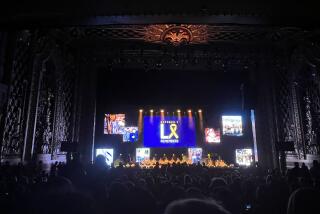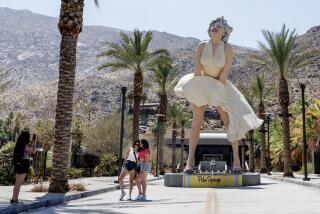Beverly Hills OKs Display of Both Menorah, Yule Tree
The Beverly Hills City Council, after a lengthy and emotional debate, has given its official blessing to the seasonal display of both a Hanukkah menorah and a Christmas tree on public park grounds.
Trying to set aside years of divisiveness over the religious symbols issue, the council voted 3 to 2 Tuesday night to draft a new law giving the candelabrum and tree a permanent side-by-side home during the holidays.
The vote followed a five-hour public hearing that pitted members of opposing Jewish groups against each other. The council’s action was prompted by a federal lawsuit filed against the city last year by the American Jewish Congress, which sought to force the removal of a 28-foot-high menorah from a city park contending it violated constitutional separation of religion and state.
The large candelabrum was installed by Chabad, a Brooklyn-based Hasidic sect that has sought for years to obtain the same prominence for the Hanukkah symbol as is given to Christmas trees.
Although the Jewish Congress lawsuit is still pending, city officials say they believe the new law will provide a basis for resolving the complaints raised by the suit. A settlement hearing on the lawsuit is scheduled next Tuesday before U.S. Magistrate Volney Brown.
Nearly 200 people, most of them evenly split between members of Chabad and numerous mainstream Jewish groups, packed the council chambers. The debate centered on the rights of a minority group to express its religious beliefs versus the propriety of any government entity to endorse a public display of specific religious symbols.
Steven J. Kaplan, vice president of the Jewish Congress, argued that the council had no obligation to erect any religious displays and suggested that it adopt a neutral policy on such symbols.
“We feel it would be entirely appropriate to pass a law banning the display of Christmas trees, menorahs, and similar religious displays,” he said.
But Marshall Grossman, an attorney for Chabad, said that because the city for years has allowed a large Christmas tree in a public park, it must not discriminate against another religious group’s symbol.
“Chabad respects the rights of all other groups,” he said. “It just wants its rights respected as well.”
Several other people argued that allowing the public display of one religious group’s symbols would invite competition from other organizations that want to publicly promote their beliefs.
Council member Robert Tanenbaum, in a lengthy review of recent Supreme Court and case law decisions, said that the city must abide by the U.S. Supreme Court’s ruling allowing the public display of such symbols.
“It would be a destructive act of public policy to disregard the Supreme Court decision,” he said. “It would be inappropriate to deny an applicant that . . . is permissible.”
Councilman Allan Alexander and Mayor Vicki Reynolds disagreed, saying that despite the high court’s ruling, the city was not required to erect any religious displays.
The issue “is not about the elimination of religious symbols,” Reynolds said. “It is . . . what is appropriate for government’s role vis-a-vis religion. And it is not our responsibility or our charge that we promote religion by allowing the display of any religious symbols on public property.”
Community correspondent Helene Laube contributed to this story.
More to Read
Sign up for Essential California
The most important California stories and recommendations in your inbox every morning.
You may occasionally receive promotional content from the Los Angeles Times.










